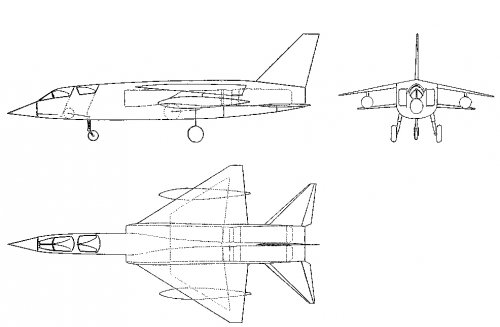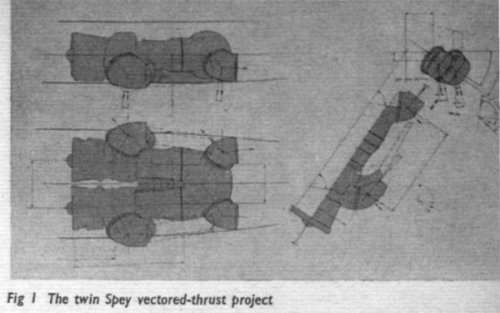Don't agree UK75, but its not a simple issue.
Type583 seems a decent enough design, though to be honest I need some better scale drawings to make a reasonable apraisal. Its effectively a British Flogger albeit with two smaller engines rather than one. The Type584 and early Type 585 really do get close to being a UK Flogger (if you ditch the lift jets), but the RN wants twin engine safety.
What it has in potentia is clearly lower Take Off and Landing speeds, along with lower weights. Lower energies at launch and recover in the scale that should permit operations from any of the RN's main CV's down to HMS Hermes.
A private paper of 1963 shows that a Type583 machine should be able to meet AW406 and exceed several parameters.
Looking at dimensions the Type583 wins out over the F4, likely theres a trade off in terms of what you can squeeze into the smaller machine, but its an acceptable one.
F4 with or without the Spey effectively kills the RN's carrier fleet. Energies are too high, size too large and thus the costs to handling them and the size of ship requred too great.
Bigger RN carriers like Malta or the '1952 CV' or CVA-01 are prohibitively expensive, too much to build, too much to run.
'57 kills the P.177, and the radar missile, with these the prolongation of the useful life of the SeaVixen. Indeed it seems funding does'nt come along for the SeaVixen until '57, suggesting its D.Sandys short term cheap option based on the assumption manned fighters will be obsolesent in ten years. It also explains why the options for higher performance are not persued and decisions over the Scimitar.
But lacking the P.177 is also a killer blow, no supersonic fighter would enter service bar the Lightning, which 'as is' was totaly unsuitable for carrier ops. Thus the RN can't pair up its P.177's with SeaVixens to provide a stopgap capability until the latter machine is replaced. So the pressure is on.
RN produces OR.346 trying to get a 'one size fits all' machine, its asked for too much and that becomes clear. So AW406 is writen and this is better, but the need to replace the SeaVixen is rather pressing as Soviet forces display large anti-ship missiles by '64 (or is it '63). Supersonic speed is felt necessary along with long range radar missile combination, but this was already being predicted based on UK technical knowledge of what was possible before the USSR showed it could produce such weapons.
At this time the F4 is the fastest route to get that with twin engines, but F4 'as is' is too marginal for operations from even Eagle and Ark Royal.
I've heard USN cross decking (maybe in the late 60's) showed they had to land on fumes and tank on launch to operate from even the largest of the UK's carriers.
RN is forced to accept NBMR.3 winner the HS1154, and we all know the RN's requirements don't match the RAF's needs.
Spey F4 was felt to be a quick and cheap option to getting the sort of machine the RN needed. It was'nt.
Rn got close to an affordable CV in the form of the Medium Fleet CV study from 1953 to 1956, seems Suez, missiles (probably SeaSlug) and the loss of the P.177 made it hard to restart after the Sandystorm. Displacement is said to be 35,000tons but that seems a standard displacement figure, since power is 135,000shp, the IJN's Akagi gets close to these figures post modernisation and had a full load of around 42,000tons. That ships length is remarkably close to the 1952 CV effort but of narrower beam and lower draught.
A 1959 study, that starts life called a 'guided weapon ship' is 45,000tons, if thats a standard figure its rather bigger, and its name is suggestive it relates to Mountbatten's ideas. Probably has SeaSlug as a SAM system onboard.
To operate the likes of the F4 with J79, or the later F14 seems you need a angled deck of 678 feet a minimum, CVA-01 seems to have one of 700ft length at 3 degrees angle.
Eagle and Ark have usable lengths of angled deck at 625ft, Victorious 544ft, Hermes with the deck edge lift up 566ft, this last ship being I think a 6 degree angled deck instead of a 'normal' 8.5 degree one. (measurements for Hermes and Vicky are such on my plans they may actualy be the same, which would'nt be that much or a surprise considering when they where designed).


